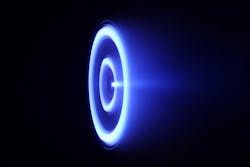K2 Space completes in-space demo and test firing of 20kW Hall-effect thruster
Summary points:
-
K2 Space completed its first in-space tech demo and tested its Hall-effect thruster.
-
The company’s 2026 GRAVITAS mission will operate in MEO, supported by a $60 million U.S. Space Force STRATFI award.
-
The K2 says its new electric propulsion system enables faster orbit-raising, expanding constellation deployment efficiency.
TORRANCE, Calif. - Satellite developer K2 Space Corporation has completed two major technical milestones in preparation for its first full satellite launch, the GRAVITAS mission, set for early 2026 to Medium Earth Orbit (MEO).
The company successfully wrapped up its first in-space demonstration mission in January 2025, validating key technologies developed in-house. Those components, including the flight computer, reaction wheel, embedded avionics, and flight software, were specifically designed to operate in the high-radiation environment of MEO. Their successful performance in orbit reduces technical risk ahead of the upcoming GRAVITAS mission, which will feature K2’s satellite platform.
K2 also completed a full-power test firing of its 20-kilowatt Krypton-fed Hall-effect thruster at its Torrance headquarters. The company says the thruster, the most powerful of its kind planned for spaceflight, will enable electric-propulsion orbit-raising from Low Earth Orbit (LEO) to MEO in under 90 days. This capability would allow K2 to deploy MEO constellations more efficiently—quadrupling the number of satellites launched per mission while reducing overall time to operational deployment.
Radiation-hardened branches out from New Space
"These milestones are a testament to our team’s engineering prowess and innovation mindset," said Karan Kunjur, CEO of K2 Space. "The successful completion of our first in-space demonstration and test firing of our 20kW Hall-effect thruster paves the way for scalable, high-performance satellites that meet the demands of both national security and commercial applications."
The 2026 GRAVITAS mission will carry multiple national security and commercial payloads and is supported by a $60 million STRATFI award from the U.S. Space Force. The mission will operate a Mega-Class satellite at multiple altitudes in MEO, combining high onboard power with multi-orbit capability.
"Both government and commercial partners are demanding more power, more capability, and lower cost," said Dr. John Plumb, K2’s Head of Strategy. "The K2 platform is built to deliver on that promise, and these milestones bring us one step closer to unlocking a fundamentally different model for how space missions are designed, launched, and operated."
